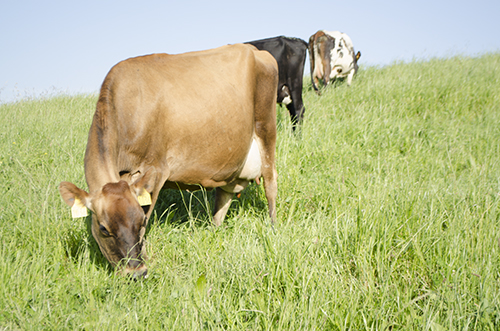
After a two-month vacation, our cows can calve in one of two ways: slow and sluggish or ready to roll. Their body condition at that time can tell us a good deal about how their lactation will progress. Ultimately, we want to avoid calving cows in either too fat or too thin and strive for a middle ground.
Body condition scores (BCS) can tell you a lot about your herd. These scores are assigned on a 1 to 5 scale, with 1 being the thinnest and 5 representing the most conditioned cattle.
A cow's desirable body condition score will vary as it progresses through lactation. Generally, though, an ideal BCS is approximately 3. If all is well and good, this should be the average for your herd.
The short ribs, hooks and pins should appear smooth and rounded without signs of fat deposits. Cows on the thinner side will have more pronounced bony structures. These same bones will be much less apparent in cows that are overconditioned. Cows that have a body condition score of 5 will have visible fat deposits, noted a recent article in the Miner Institute Farm Report.
The University of Missouri has developed guidelines for where on the scale your cows should fall throughout their lactation:
Fresh cows (0 to 4 weeks after calving): Cows should calve at a condition score between 3 and 3.5. After four weeks in lactation, cows should not have fallen below a score of 3 to 2.5.
Early lactation (1 to 4 months): At this stage, the recommended BCS is 2.5 to 3. Maintaining cows in the BCS 3 range helps them regain a positive energy status.
Mid-lactation (4 to 8 months): Shooting for a body condition score of 3 allows cows to meet or slightly exceed energy requirements so they can build up body reserves.
Late lactation (8 months to dry-off): Nutritionally, your goal at this point in lactation is to completely replenish body fat reserves yet prevent overconditioning. Therefore, a body condition score of 3.5 should be targeted. Cows that are excessively overweight when they freshen are at a much greater risk of complications during and after calving.
On the contrary, cows that are too thin when lactation commences may not experience health issues at first, but subsequent production and reproductive performance could be negatively affected.

The author is an associate editor and an animal science graduate of Cornell University. Smith covers feeding, milk quality and heads up the World Dairy Expo Supplement. She grew up on a Medina, N.Y., dairy, and interned at a 1,700-cow western New York dairy, a large New York calf and heifer farm, and studied in New Zealand for one semester.








